Weeds 101: Pond Weeds
What Is That Algae Problem?
Staff and volunteers at Bloedel Reserve field a lot of questions from visitors. One question in particular has been very common this summer: “What are you doing about the algae problem in your pond?” Surprisingly, the accurate answer is “We don’t have an algae problem.” Allow us to explain.
When most visitors ask about the algae, they are usually asking about the largest pond on the more manicured portion of the grounds, which is called the Mid-Pond. (The Buxton Bird Marsh pond is larger, by the way.) In the warmest months, the pond water heats up and what looks like green “algae” grows quickly to cover much of the surface. If you go down to the water’s edge and scoop up a handful of the green muck, you will see something that looks like very tiny green pellets.
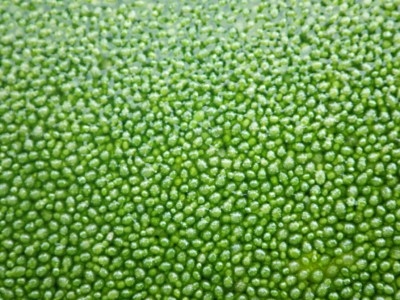
Believe it or not, these pellets are actually a very, very tiny species of flowering plant called Watermeal, or Wolffia. And yes, they actually can produce flowers although they are microscopic and not visible to the naked eye.
While Watermeal may produce some seeds, it mainly reproduces by “budding off” new plants from older ones. Budding off is much faster than propagation by seeds and that allows Watermeal to quickly cover the Mid-Pond in warm, sunny weather.
Not Algae, Pond Weeds
So when we say we don’t have an algae problem at Bloedel Reserve, that is technically correct. We have a pond weed problem instead. And it is a recurring problem every year. The reason this problem is more noticeable this year than in previous years is actually due to COVID-19.
Early on in the pandemic, Bloedel Reserve was closed to everyone for nearly three months, including most staff members (except for those engaged in essential duties). As a result, the Horticulture & Grounds crew is behind in its garden work. Pond-skimming became a lower priority on the list of tasks we need to do to catch up. In years past, we have tried to have the Watermeal skimmed off the Mid-Pond before the summer Garden Party that we usually host on the grounds in August. But since COVID-19 has prevented us from scheduling any onsite group events this summer, that particular skimming deadline was not a factor this year.
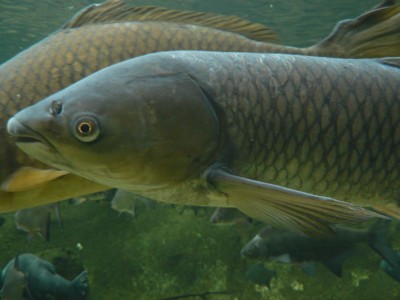
Carpe Diem
In the coming years, our pond weed problem should decrease thanks to a secret weapon. Last year, the Washington State Department of Fish and Wildlife granted Bloedel Reserve a permit to introduce 10 certified, triploid Grass Carp into the Mid-Pond. Grass Carp eat pond weeds. It will take a few years before our Grass Carp can catch up with the volume of weeds in the Mid-Pond.
However, since Grass Carp is an invasive species in Washington State, our facilities first had to be inspected by WDFW employees. Specifically, we had to install a grate in the Mid-Pond to prevent the escape of any fish, on the off-chance that some are not actually triploid. “Triploid” carp have an odd number of chromosomes in their cells that causes them to be sterile. We purchased our fish from a facility that produces certified triploid Grass Carp. The WDFW permit limits us to adding a maximum of 10 carp to the pond now. We can reapply for more fish after five years.
Grass Carp were actually introduced to the Bloedel Mid-Pond back in the 1990s and they did a phenomenal job of controlling pond weeds. No skimming was necessary. As it happens, eagles and otters eventually discovered the carp and, over a period of several years, ate them until none were left. The result? The pond weeds then slowly made their way back into the Mid-Pond. We know that Nature will likely take its course with this new batch of Grass Carp as well.
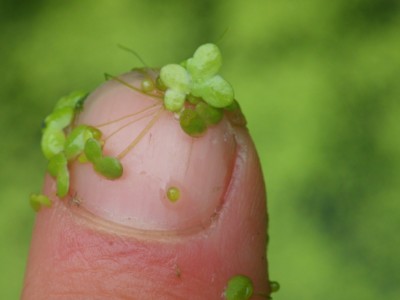
A Near-By Relative
Watermeal is sometimes erroneously called “Duckweed” (although the two plants are closely related). Duckweed is, in fact, very common at Bloedel Reserve but Watermeal seems to dominate the Mid-Pond. The pond downstream from the Mid-Pond, called the “Swan Pond” (though we no longer have swans on the grounds), usually grows a crop of Duckweed in late summer.
Watermeal and Duckweed are easy to distinguish from each other. Watermeal is smaller, pellet-shaped, and lacks roots. Duckweed is small but still larger than Watermeal and has roots that hang down into the pond water. Duckweed plants are flat and round, resembling very tiny lily pads.
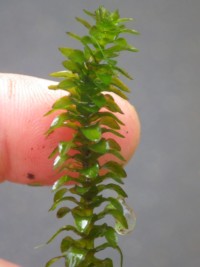
Weeds Under Water
Another pond weed you may encounter is Elodea canadensis, also called American or Canadian Waterweed. Unlike Watermeal and Duckweed, American Waterweed actually looks like a plant with true stems and leaves. It is less noticeable in the ponds at Bloedel because it grows completely submerged and because Watermeal dominates the water’s surface.
There is actually quite a lot of American Waterweed in the Mid-Pond. Our grass carp actually prefer American Waterweed to Watermeal, so they may not have a noticeable impact on the Watermeal until they eat all the American Waterweed first.
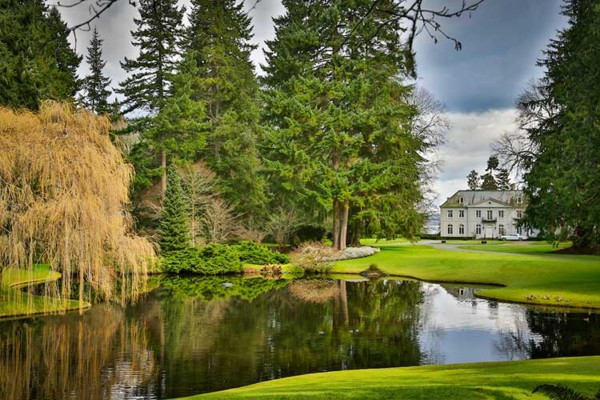 An Aquatic Garden
An Aquatic Garden
Rather than looking at the Mid-Pond as having a pond weed problem, this year we prefer to consider it a temporary aquatic garden. Next year, assuming things are back to normal, we will be able to skim the pond and give it that summer reflective surface that our guests are more accustomed to seeing.
SIGN UP FOR OUR ENEWSLETTER
Stay up to date on all of the events and activities taking place at Bloedel Reserve.

